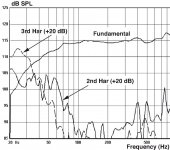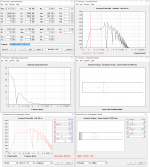My hypothesis is that much commercial (PA) equipment, when driven at much lower SPL, may be cost-effective for demanding domestic use. For example, an 18in JBL 2268H(PL) that is very low in distortion might be safely driven to a more audiophile low frequency limit. It's FR is 33Hz and my two specimens measure half power f3 of 45Hz. They already sound very nice crossed-over at up to 120Hz to compatible 2-way systems, adding impressive reproduction of double bass viols with C-extension (32.7Hz fundamental) and 40in orchestral bass drum. The question is, for use listening at ~16ft (5m) in a large acoustically treated home theater playing at SMPTE standard SPL (85dB nominal, 105 peak, ~108 maximum with all channels of low bass redirected, +LFE), could they be EQd safely and still with low distortion to say 30Hz or even lower?
Last edited:
I'm assuming they are ported boxes, and being PA boxes they would be tuned fairly high (maybe 35Hz or even higher)
Boosting below tuning frequency is not a great idea (there is no loading on the driver).
Maybe stuffing the ports to turn the boxes into sealed ones and then EQing would work better.
Rob.
Boosting below tuning frequency is not a great idea (there is no loading on the driver).
Maybe stuffing the ports to turn the boxes into sealed ones and then EQing would work better.
Rob.
EQ 6dB at 33Hz after port extension mods?
Thanks, Rob. I am thinking port extension modifications to tune the box ~1/2 octave lower?
The idea is still low distortion for continuous program (well below instantaneous peaks), as per Fletcher-Munson (ISO 226:2003), harmonics are disproportionally more audible than fundamentals. But I'd like to extend this box's measured f3 of 45Hz (cf. manufacturer's 718S data below showing system f3 a bit lower) to around the driver's resonance of 33Hz in order to reproduce more naturally orchestral instruments' low C, maybe the 27Hz of an 88key piano. With system sensitivity of 95SPL/1w/1m, the expected peak level not including LFE of 108SPL at 16ft (5m) calculates to (anechoic worst case) <400w, 1/4 (-6dB) the driver's "program" rating. So I expect the 2268 driver should be capable of 6dB of EQ without undue distortion - the data show <10% at 33Hz and 108SPL that would represent only instantaneous peaks. Would this goal be possible after extending the 718S's two 4in diameter 9in long ports?
Thanks, Rob. I am thinking port extension modifications to tune the box ~1/2 octave lower?
The idea is still low distortion for continuous program (well below instantaneous peaks), as per Fletcher-Munson (ISO 226:2003), harmonics are disproportionally more audible than fundamentals. But I'd like to extend this box's measured f3 of 45Hz (cf. manufacturer's 718S data below showing system f3 a bit lower) to around the driver's resonance of 33Hz in order to reproduce more naturally orchestral instruments' low C, maybe the 27Hz of an 88key piano. With system sensitivity of 95SPL/1w/1m, the expected peak level not including LFE of 108SPL at 16ft (5m) calculates to (anechoic worst case) <400w, 1/4 (-6dB) the driver's "program" rating. So I expect the 2268 driver should be capable of 6dB of EQ without undue distortion - the data show <10% at 33Hz and 108SPL that would represent only instantaneous peaks. Would this goal be possible after extending the 718S's two 4in diameter 9in long ports?
Attachments
The easiest way to see if it will work would be to model the boxes you are using now, and the boxes you intend to use with the longer ports in winISD or a similar program.
With the later version of winISD you can apply filters to the simulation so you could add your 6dB boost, and see how it affects excursion and vent mach.
Cheers,
Rob.
With the later version of winISD you can apply filters to the simulation so you could add your 6dB boost, and see how it affects excursion and vent mach.
Cheers,
Rob.
I can't find all specs of this driver but I assume you don't have that driver already. For a quick sim I choose a driver with similar Fs and Qts. An 18" Beyma I could buy here for €250,=
I think you can tune below Fs, but not too much. 25 Hz is possible.
Here you see big line with offset driver. It's tuned to smooth out the first harmonic of around 80 Hz. If you can lowpass around 100-120 Hz you will have a very flat bass.
I think you can tune below Fs, but not too much. 25 Hz is possible.
Here you see big line with offset driver. It's tuned to smooth out the first harmonic of around 80 Hz. If you can lowpass around 100-120 Hz you will have a very flat bass.
Attachments
I can't find all specs of this driver but I assume you don't have that driver already. For a quick sim I choose a driver with similar Fs and Qts. An 18" Beyma I could buy here for €250,=
I think you can tune below Fs, but not too much. 25 Hz is possible.
Here you see big line with offset driver. It's tuned to smooth out the first harmonic of around 80 Hz. If you can lowpass around 100-120 Hz you will have a very flat bass.
I have two 2268s in SRX718S cabinets. The T-S parameters are attached, 3rd row from the bottom. I'd appreciate if you'd check your simulation against these parameters before I rely on it, but many thanks.
Attachments
Hmm, neither of these are technically correct, so as always best to measure yours, though being JBL prosound, historically any of the three are adequate for designing basic sealed, vented cabs.
The main question is what is the cab's net volume [Vb]?
The main question is what is the cab's net volume [Vb]?
I have two 2268s in SRX718S cabinets. The T-S parameters are attached, 3rd row from the bottom. I'd appreciate if you'd check your simulation against these parameters before I rely on it, but many thanks.
No problem RCAgay. Now it's time to find a set up that fits. A line of 285 cm will probably not fit easy in room, so you need to make folds.
Attachments
285cm (~9ft) seems about right for a VLF horn - scales to my Community Extended Leviathan, about 4ft deep for an f3 of 50Hz. But I don't see how this applies to extending the port lengths (2) of an existing reflex box?
I thought you were looking for a design for your drivers to give them some extension. You have an existing box? What specs?
RCAguy,I have two 2268s in SRX718S cabinets. The T-S parameters are attached, 3rd row from the bottom. I'd appreciate if you'd check your simulation against these parameters before I rely on it, but many thanks.
The 23mm listed for the JBL 2268 in the TS parameters is incorrect, it is actually the Xmech (Xlim) of the driver. The JBL 2268 Xmax is around 8mm, THD will climb above 10% when driven past 8mm one-way excursion.
Extending the ports for a lower tuning will work fine for low distortion output up to Xmax. The relatively small box of the SRX718S will result in a much reduced sensitivity at Fb of 33Hz.
The dual 18" SRX728 has about 1.5 cubic foot more volume per cone, and is tuned around 36Hz, resulting in around -6dB at Fb.
I'd estimate the SRX718S smaller cabinet volume with ports extended to a 33Hz Fb would be around -10dB at 33Hz.
For home use, if equalized for flat response to just below Fb, I'd prefer trading output for the extended low frequency response.
Art
Attachments
Last edited:
Many thanks, Art. I was aware of the Xmax typo (and that Le is lower), but was only going by SPL curves anyway. Along with not wanting to compromise the driver's low distortion. My boxes measure f3=45Hz, a bit off JBL's publications.
I haven't opened either SRX718S box to measure the vent lengths (2 per box), but from JBL's tech sheet they appear to be ~9in. I'll calculate the volume from external dimensions minus wall thickness, then find the best app to simulate the port extensions for 33Hz, or whatever gets me flatfish sensitivity toward low C.
I haven't opened either SRX718S box to measure the vent lengths (2 per box), but from JBL's tech sheet they appear to be ~9in. I'll calculate the volume from external dimensions minus wall thickness, then find the best app to simulate the port extensions for 33Hz, or whatever gets me flatfish sensitivity toward low C.
Maybe you didn't apply the recommended 80 Hz 24dB/octave HPF and 80 Hz 24dB/octave LPF ;^).My boxes measure f3=45Hz, a bit off JBL's publications.
An F3 of 45Hz sounds pretty close to JBL's 718 graph, which doesn't look anything like a F3 of 34Hz..
Attachments
I suppose to be competitive, JBL has started using “+\-3dB” instead of the engineer-preferred -3dB (f3). So their 34Hz spec is likely -6dB, which is closer to their curve.
- Home
- Loudspeakers
- Subwoofers
- Safe commercial subwoofer low frequency extension EQ





